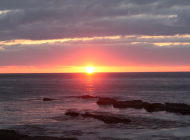
国見地区では古くから伝わるイベント行事がたくさんあります。
0776-88-2316
福井県福井市鮎川町109-9-2

「自ら目標を持ち、主体的・創造的・協働的に学ぶ生徒」
「豊かな心を持ち、自他の人格を尊重し、認め合える生徒」
「ふるさとに誇りと愛着を持ち、たくましく生きる生徒」

国見地区では古くから伝わるイベント行事がたくさんあります。
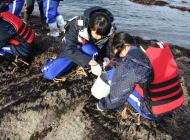
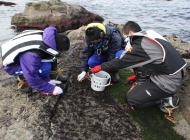
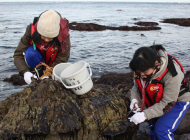
この活動は海が近いから始めました。
55年前の昭和36年に青木先生が始めました。
採ったのりは施設や市場におすそわけしました。
また、お金にして先生方にそのお金で本を買ってもらいました。
2時間くらい採ります。天然の岩のりは珍しいです。
(英)
This activity started because of our proximity to the ocean.
It originated 55 years ago, in year 36th of the Showa era.
The collected seaweed was shared around town and at the market.
Nowadays, the money from the seaweed is used by our teachers to buy books for us.
We usually spend about 2 hours gathering it.
Naturally occurring Iwanori is rare.
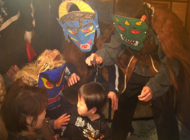
福井市白浜町に400年以上伝わる節分の奇習「あまめん」。
鬼の面をかぶった地元中学生らが、小さな子がいる家を訪問します。
「悪い子はおらんかー」と大声を上げ、子どもたちの健やかな成長を願います。
あまめんは、秋田のなまはげに似た伝統行事で由来は、住民によると「鬼面(おにめん)」がなまったとされています。
見開いた目、むき出しの長い牙の恐ろしげな鬼たちは、玄関を開け「お父さん、お母さんの言うことを聞くかー」とうなり声を上げます。
30年ほど前に地元中学生があまめんのお面を作ったといわれています。
(英)
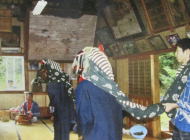
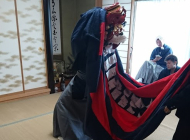
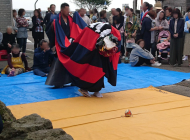
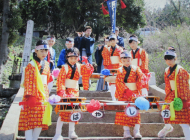
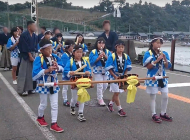


鮎川や、白浜、大丹生などどこの地区でもしていて、一軒、一軒に丁寧にお祈り(剣の舞)をしていきます。
各家で、お酒等の接待をうけます。
鮎川の神は、男が好きで女にお祭りをやらせないという伝統があります。
(英)
Shinto Ritual House Visits.
・A portable shrine is carried from house to house offering prayers.
・Every town around the area has its own customs, such as the “Sword Dance” ritual. Some townspeople dress as divine beasts called “Shishi” which look like a mix of a lion and dog.
・At each house, sake and other such things are served.
・The god at Ayukawa is said to prefer males, women are not traditionally allowed to participate in the festival there.
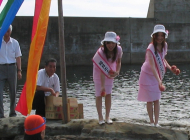
国見小学校の児童が来ており、式の終わりに海に放った桃や、式中に放流したサザエを潜って採りながら、海水浴を楽しみました。
なぜ、桃をなげるのでしょう?
むかしむかし、鮎川の御嶽山のあたりには桃の木がいっぱいあったそうです。
春になると美しい花が一面に咲いて、夏になると、あまいあまい実が鈴なりになっていました。
ある年のこと、どっかから一人の旅の坊さんが、ひょろひょろと登って来ました。
「あまり暑うて、のどからからや。どうかひとつ、その桃をわけてくださらんかの」
と少しはなれたところで、桃をもいでた婆さんにたのみました。
よくばり婆さんは、よう聞こえたけど、しらん顔をしていました。ほしたらまた、坊さんは、まえよりもいけえ声で頼みました。
ほしたら、「どこの馬の骨かわからんものに、ひとつでもやれるかいの。これは、桃じゃのうて、椿の木じゃ」 と婆さんは、声をはりあげてどなったそうです。
それで坊さんは、だまって山をおりていきました。
あくる日、村じゅうが大騒ぎになりました。山の中の桃の木がみんないっぺんに椿の木にかわったそうです。
なので、桃をなげているそうです。
(英)
For the Umibiraki Festival, we stock the nearby sea with sazae snails and cast peaches into the ocean.
Why do we throw peaches into the sea, you ask?
It’s said that long ago, there were numerous peach trees in and around the mountains near Ayugawa.
In the spring, beautiful flowers would bloom on one side of the mountain’s face, and in summer the trees would overflow with super sweet fruit.
Around that time, a lone and frail monk passed through the mountains on his journey.
“It’s hot and my throat’s feeling a little dry… Would it be ok for me to have one of those peaches?” asked the monk to an old woman who was a little ways away tending to the peaches.
The covetous woman heard him well, but pretended not to.
The monk was desperate however, so he asked in a louder voice than before.
The old woman raised her voice and answered, “I would never give something like that to someone I don’t know at all.
Anyways, this is a camellia tree. There aren’t any peaches.”
After hearing that, the monk continued down the mountain without saying a word.
The next day, there was a clamor among the nearby townspeople. Everyone said the peach trees on the mountain had changed into camellia trees all at once!
So it became that to pray for the return of the peach trees, people began casting peaches into the open sea.
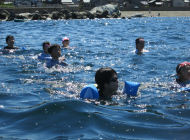
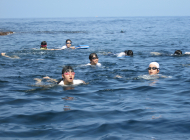
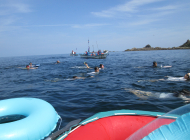
昭和43年からはじまりました。
その当時は六月:県中選抜水泳大会、八月上旬:遠泳大会、中旬:校内水泳大会、下旬:県学年別水泳大会、七月中旬:水泳訓練、一月中旬:寒中水泳大会など水泳に関係する行事がたくさんありました。
そのおかげなのか、水泳部はとても強かったそうです。
海が近いという理由で始まった遠泳大会なので、それほど重要ではありません。
しかし、ずっと続いているのでこれからも遠泳大会を守っていきたいです
(英)
This long-distance swimming event started in the 43th year of the Showa era.
At that time it was held in midwinter, when the water was the coldest.
The custom started, like many of our other tradition, because we are close to the sea.
Our swimming club was very strong.
We want to keep the tradition going strong from now into the future.
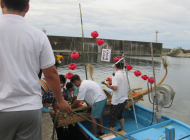

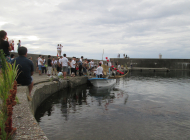
おしゃら舟は毎年8月15日に行われます。
白浜町にある欣浄寺という寺が1643年にできてから約380年続けています。
おしゃら舟とは、先祖の霊を慰めお盆にやってきた霊(先祖)を西方浄土に帰すためにする行事です。
舟の材料は、竹とススキなどで中学生と地域の人が作っていました。
それにお墓参りのときのお供え物をのせて舟で沖まで持っていって流します。
亀島の先が見えるくらいまで行きました。今年はうまく流れました。
(英)
“Osharabune” happens on August 15th every year.
It was first held by Gonjyoji Temple at Shirahama-cho in 1643, and the tradition has continued for about 380 years.
Osharabune is a ceremony performed to comfort the spirits of our ancestors.
The spirits that visit during Obon are sent back on a boat to the Western Pure Land, one of the Buddhist paradises.
The boat is made of bamboo and special dried grass among other things and is constructed by students and people in the area allowed to drift out into the open sea.
*It drifted very well this year, going out as Kamejima.